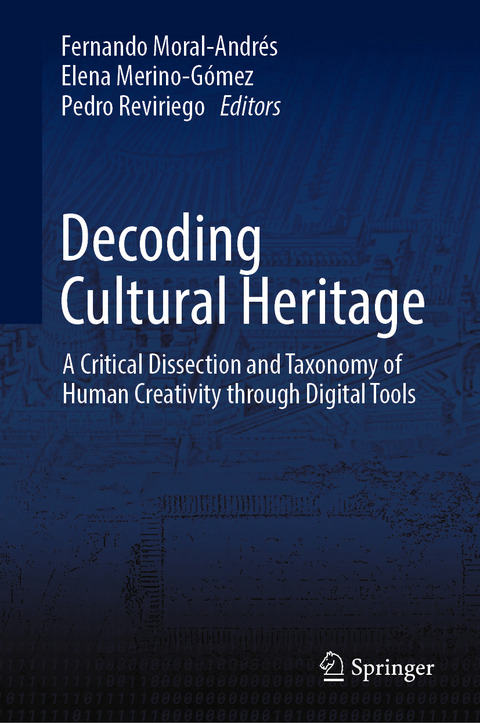
Decoding Cultural Heritage
Springer International Publishing (Verlag)
978-3-031-57674-4 (ISBN)
This book provides readers with an overview of the use of digital techniques for cultural heritage preservation. Those include image processing, advanced sensing, geomatics or virtual and augmented reality. The use of newer tools such as generative artificial intelligence for images and 3D or advanced natural language processing systems is also considered. The ultimate goal is to provide readers with a global perspective of the state of the art on the use of digital tools for cultural heritage applications, both for researchers and professionals involved in cultural heritage and for computer scientists and engineers that design and develop technologies that can be used for cultural heritage preservation.
Fernando Moral-Andrés is the director of the School of Architecture at Universidad Nebrija, Madrid. He holds M.Arch and Ph.D. in Architecture from Universitatat Politècnica de Catalunya - BarcelonaTech and a degree in Architecture from Universidad de Valladolid. He has been Visiting Professor of Sapienza - Università di Roma. His research interests include public city, art and the intersection of architecture and technology focusing on the use of digital technologies in different aspects of this discipline such as territorial resilience, design and cultural heritage.
Elena Merino-Gómez is an assistant professor in the School of Industrial Engineering at Universidad de Valladolid. She holds an undergraduate degree and a Ph.D. in architecture from Universidad de Valladolid and a Master in applied linguistics from Universidad Antonio de Nebrija. Her research interests include the history of architecture, ancient Western culture, and linguistics and the useof generative artificial intelligence in those areas.
Pedro Reviriego received the M.Sc. and Ph.D. degrees in Telecommunications engineering from Universidad Politécnica de Madrid, Madrid. He has worked in the industry developing routers and communications ASICs, mostly Ethernet transceivers and in several Universities. He is currently an associate professor at Universidad Politécnica de Madrid working on several topics in computer science with a focus on artificial intelligence. In particular, dependability and performance optimization of artificial intelligence algorithms and the use of generative artificial intelligence for cultural heritage and architecture.
Part I. Cultural Heritage and Artificial Intelligence: a new relationship between past and future times.- 1. Can Artificial Intelligence mark the next architectural revolution? Design Exploration in the realm of Generative Algorithms and Search Engines.- 2. Generative AI and the History of Architecture.- 3. Word pictures: New insights through AI around the Villa Laurentina by Pliny the Younger.- 4. Analysis of the Usability of Automatically Enriched Cultural Heritage Data.- 5. Cultural Relic Image Retrieval Based on Artificial Intelligence.- Part II. Foundational challenges beyond prompts: how Artificial Intelligence and Machine Learning can deal with ancient texts.- 6. The Artificial Papyrologist at Work.- 7. AI for the Restoration of Ancient Inscriptions: A Computational Linguistics Perspective.- Part III. How data, digitization and reproduction can open up new realities in visual historical heritage.- 8. Bridging the Gap: Decoding Abstract Concepts in Cultural Heritage Images.- 9. Decoding Pictorial Collections Using Faces.- 10. Digitization and Reproduction of Surface: Shedding New Light on Goya's Black Paintings.- 11. Manufacturing of sculpture in the digital age.- Part IV. Digitalisation and Artificial Intelligence for architectural heritage intervention and conservation.- 12. Digital Palimpsest: Transformation of Alois Riegl's Modern Cult of Monuments.- 13. 3D Scanning of an Architectural Sculpture Using a Smartphone with LiDAR Sensor: The Case of The Late-Gothic Helical Stair.- 14. The impossible cathedral of Mejorada del Campo, Madrid: utilizing digitalization to comprehend its geometry and behavior..- 15. Harnessing Audio-based Augmented Reality for Digital History and Cultural Heritage Experiences.- 16. 3D Heritage: Preserving Historical and Cultural Heritage through Reality Capture and Large Scale 3D Printing.- Part V. The historic urban territory as a focus for digital experiences.- 17. Segovia, heritage, and city. From the Special Plan for Historic Areas to the Smart Digital Project: new strategies for heritage planning and preservation..- 18. Modeling and Monitoring the Rosenwald Ideal: Digital Documentation and Preservation at the Tankersley Rosenwald School, AL.- 19. Immersive Art and Urban Heritage: An Interdisciplinary Study of Socio-Environmental Justice in Houston and Amsterdam.- 20. Digital Citizenship in the Interactive Dissemination and Perception of Cultural Heritage - The Museum Case.
| Erscheinungsdatum | 03.07.2024 |
|---|---|
| Zusatzinfo | XV, 479 p. 218 illus., 189 illus. in color. |
| Verlagsort | Cham |
| Sprache | englisch |
| Maße | 155 x 235 mm |
| Themenwelt | Technik ► Elektrotechnik / Energietechnik |
| Schlagworte | Computing and Cultural Heritage • Digital Cultural Heritage • Digital Imaging for Cultural Heritage Preservation • Digital Techniques for Cultural Heritage • Technology cultural heritage |
| ISBN-10 | 3-031-57674-8 / 3031576748 |
| ISBN-13 | 978-3-031-57674-4 / 9783031576744 |
| Zustand | Neuware |
| Haben Sie eine Frage zum Produkt? |
aus dem Bereich


